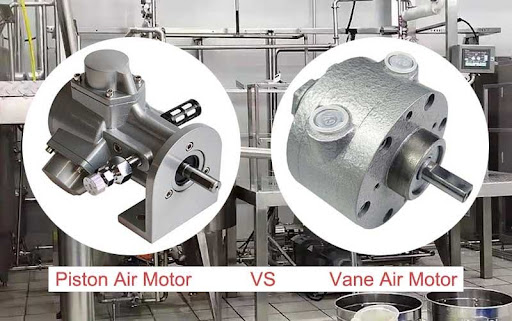In today’s fast-paced manufacturing and industrial environments, downtime is a costly enemy. Major loss of productivity, delayed shipments, and higher operating costs might result from even a brief unscheduled shutdown. The air motor is one often overlooked option that can significantly increase system reliability.
Because of their capacity to lower downtime, improve safety, and streamline maintenance, these small, strong, and adaptable gadgets are becoming increasingly popular across different industries. This article will discuss how air motors increase efficiency, why they are frequently chosen over different power sources, and how to include them in your current systems.
What Are Air Motors?
Air motors, also known as pneumatic motors, are devices that convert compressed air energy into mechanical work. Unlike electric or hydraulic motors, air motors rely on air pressure, which makes them inherently safer and often more reliable in harsh working environments.
They come in various designs such as vane air motors, piston air motors, and turbine motors—each suited for different applications depending on torque, speed, and load requirements.
The True Cost of Downtime
Before we dive into how air motors help, it’s important to understand why minimizing downtime is so critical.
- Lost productivity: A stalled production line can bring your entire operation to a halt.
- Increased labor costs: Workers may be idled or diverted to unproductive tasks during unplanned maintenance.
- Higher maintenance costs: Emergency repairs are usually more expensive than scheduled ones.
- Customer dissatisfaction: Delay in production can result in missed delivery deadlines and lost business.
Air motors address these issues by offering a robust and resilient alternative to conventional power sources.
How Air Motors Reduce Downtime
Let’s take a closer look at the specific ways air motors contribute to better uptime and smoother industrial operations.
1. No Risk of Electrical Failure
Especially in moist or explosive conditions, electric motors are at risk of overheating, short circuits, and voltage decreases. However, because air motors are completely non-electrical, there is no chance of electrical failures at all.
This makes them perfect for use in hazardous situations where uptime and safety are crucial, including chemical plants, oil rigs, or food processing units.
2. Self-Cooling Mechanism
Air motors, as compared to electric motors, automatically cool themselves as air expands within them. By preventing overheating during continuous operations, this self-cooling feature lowers the possibility of thermal overload-related shutdowns.
This means you can run air motors for extended periods without worrying about heat-related damage or forced cooling breaks.
3. Instant Start and Stop Capability
Air motors offer instant start and stop functionality, which is essential in processes requiring precision and control. This feature not only enhances safety but also reduces wear and tear, leading to fewer breakdowns and less time spent on maintenance.
Electric motors, on the other hand, could require controlled shutdowns or warm-up moments, which increase downtime.
4. Simple, Low-Maintenance Design
Compared to their electric equivalents, air motors have fewer moving parts. Because of their solid simple design, there are fewer potential problems, and fixing them is simpler and faster when it arises.
In many cases, minor issues can be handled in-house without the need for specialized technicians, drastically reducing Mean Time to Repair (MTTR).
5. Operational Flexibility
Controlling the air supply makes it simple to modify the speed and torque of air motors, which can operate in either clockwise or counterclockwise directions. Because of its versatility, a single air motor can handle a variety of work, which helps reduce machinery and cut down on the number of parts required, which lowers the chance of failure.
6. Continued Operation During Power Outages
In facilities where downtime isn’t an option, such as hospitals or 24/7 manufacturing plants, air motors provide a reliable backup. Since they don’t depend on electricity, they can continue running during power failures—either via stored compressed air or by switching to generator-supported air systems.
Real-World Applications Where Downtime is Reduced
- Food & Beverage Processing: In washdown areas, air motors continue running without the risk of water damage, unlike electric motors.
- Mining Operations: The spark-free nature of air motors ensures that they operate safely and continuously even in dust-heavy, explosive environments.
- Automotive Assembly Lines: Air tools powered by air motors are preferred due to their reliability and ease of maintenance, ensuring minimal interruptions.
Things to Consider When Using Air Motors
While air motors offer numerous advantages, it’s important to keep the following in mind to maximize uptime:
- Ensure consistent air pressure from your compressor system.
- Install filters and lubricators to maintain a clean, dry, and well-lubricated air supply.
- Choose the right type and size of air motor for your load and speed requirements.
A properly specified and maintained air motor can easily outlast electric counterparts, especially in demanding conditions.
Conclusion
In industrial systems where every second counts, air motors provide a compelling case for reducing downtime. These are an ideal choice for many important applications because of their solid design, safety advantages, low maintenance requirements, and versatility.
If you’re struggling with frequent stoppages or costly breakdowns, it may be time to rethink your equipment strategy and explore how air motors can fit into your system design.
Visit ATO Air Motors, to learn more about choosing the right air motor for your specific industrial application.






